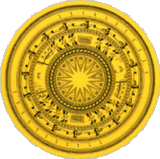


A PUBLICATION OF CLASS COM 492 AT CONCORDIA UNIVERSITY IRVINE - SPRING 2010 FIRST EDITION
© The League of Faithful Masks
Ad-Min 312-A, 1530 Concordia West, Irvine, CA 92612
949-705-6550
Ad-Min 312-A, 1530 Concordia West, Irvine, CA 92612
949-705-6550


Vietnam, a Confounding Land
Historical, cultural, social, political and economic facts
By QUY V. LY
Historical, cultural, social, political and economic facts
By QUY V. LY
Sociology and Culture: The Vietnamese originally lived as scattered tribes called Lac Hong along the Red River Delta in northern Vietnam. For more than a millennium until 939 A.D., they were under the domination of China, which influenced all social and cultural aspects of their civilization. Like the Chinese, more than 80 percent of today’s Vietnamese still follow the Confucian way of life honoring ancestors and attaching great importance to family, societal hierarchy and education.
Confucianism is an ethical and philosophical system rather than a religion. Strictly speaking, most Vietnamese would define themselves as non-religious. Only 9.3 percent are Buddhists and 6.7 percent Catholics, according to the CIA The World Fact Book of 2008. The number of Protestants is estimated between 500,000 and 1 million; however, as in China, an unsanctioned “house church” movement appears to be growing robustly defying Communist persecution. Vietnam also possesses homegrown religions such as the Cao Dai, a colorful syncretistic sect, and the Hoa Hao, an austere form of Buddhism that used to maintain its own militias.
From 939 A.D. to the 19th century, Vietnam was independent. It enjoyed long prosperous periods sometimes interrupted by internal conflicts and external threats from China in the North. From 1858 to 1954 the French dominated the country, injecting a European element into Vietnamese culture, notably Christianity. Under French rule, a Latin-based alphabet developed in the 17th century by Jesuit missionary Alexandre de Rhodes gradually replaced the Vietnamese script based on Chinese characters.
Political: Politics in Vietnam seem particularly perplexing to outsiders. Traditionally, Vietnam had been a feudal society headed by a monarch. The French conquest in the 19th century divided the country into three parts:
1. The agriculturally rich southernmost region became an outright French colony called Cochinchina.
2. Central Vietnam (Annam) was solely the realm of the Emperor.
3. North Vietnam (Tonkin) was turned into a protectorate over which the Vietnamese Emperor and the French held shared authority.
In 1930, Nguyen Thai Hoc and his Vietnam Nationalist Party, initiated the so-called Yen Bay uprising. For a brief period, they took control of many provinces in North Vietnam. The revolt was quickly suppressed; Nguyen Thai Hoc and 12 of his associates were guillotined.
However, this occurrence paved the way for a more hard-line anti-French liberation movement under a “unified front” called Viet Minh (Allied Vietnamese). Their leader was Ho Chi Minh, a founding member of the French Communist Party who in the 1920s had become the leading operative and colonial war theorist of the Soviet-led Communist International (Comintern) in Asia. In order to dispense with non-Communist rival, Ho betrayed Phan Boi Chau , head of a large non-Marxist anti-colonialist faction, to French police in Shanghai for 100,000 Indochinese piastres (Davidson, Phillip B., Vietnam at War: The History: 1946-1975 (1991), p. 4).
In 1945, at the end of World War II, the Japanese invaded Indochina (Vietnam, Laos and Cambodia) ousting the French. A few months later Japan surrendered unconditionally to the Americans.
Seizing this opportunity, Ho’s Viet Minh took control of the Vietnam and formed a “provisional government” dominated by the Communists. A few months later, the French restored their rule in Indochina and with British help. Viet Minh forces retreated into the jungle and initiated a guerilla war lasting nine years.
In 1954, the French lost the climactic battle of Dien Bien Phu in northwestern Vietnam, and Vietnam regained its sovereignty. (History of the Vietnam War, Part One, 2008). However, soon after independence, the Communist party purged all other non-communist elements from the United Front. The conflict between Communists and pro-western factions in Vietnam was temporarily resolved in the same year in a conference between the Soviet Union, China, the United States, France and the United Kingdom.
The conference resulted in the so-called Geneva Accords of 1954, which the U.S. did not sign. This treaty divided Vietnam provisionally along the 17th parallel. North Vietnam became a Communist-style “People’s Republic” with Hanoi as capital. South Vietnam remained at first under the reign of emperor Bao Dai, who was overthrown in a coup d’état by his prime minister Ngo Dinh Diem one year later. Nearly one million North Vietnamese fled to the South, while a relatively small number of South Vietnamese went north.
From 1955 until 1975, South Vietnam was a pro-western republic governed from Saigon. But the two Vietnams soon became a hot battleground of the Cold War. In 1960, the ruling “Workers’ Party” of North Vietnam founded the “National Liberation Front of South Vietnam,” the Viet Cong. It launched a three-phase “war of national liberation” against the Saigon government, following a strategy developed by North Vietnamese defense minister Vo Nguyen Giap, a former schoolteacher.
These phases were: (1) agitation and propaganda, followed by (2) guerilla warfare and terrorism, and finally (3) all the above plus conventional warfare including an invasion by regular North Vietnamese forces.
The United States and other Western nations provided at first military assistance, advice and naval and air support to South Vietnam. In 1965, the U.S. sent regular forces gradually increasing their number to more than 500,000 men. They were joined by forces from South Korea, Australia, New Zealand and other nations.
Public opinion the United States eventually turned against the Vietnam War, especially after the 1968 “Tet Offensive” when the Communists broke a temporary ceasefire for the lunar New Year festivities. Overnight, North Vietnamese and Vietcong troops attacked more than 100 towns and cities in South Vietnam. Although this offensive ended in a military disaster for the Communists, it was popularly perceived in America as a catastrophic setback for the United States and its allies resulting in the announcement by President Lyndon B. Johnson that he would not seek reelection.
Under his Republican successor, Richard M. Nixon, peace talks were held in Paris resulting in the withdrawal of conventional U.S. forces from South Vietnam in 1972. In April 1975, the Communists conquered Saigon. Hundreds of thousands of South Vietnamese fled their homeland; in subsequent years, 1.5 million more risked their lives fleeing Communist persecution on mostly unseaworthy vessels. Many drowned.
Meanwhile in Vietnam, the ruling Communist Party maintained a tight grip on power rejecting all calls by the international community and Vietnamese exiles for political pluralism. However, the Party eventually switched to a free-market economic system.
Technology: This was primarily due to technological factors sparking tremendous structural changes 10 years ago. The Hanoi government adopted a policy of integration into the world free-market economy by joining ASEAN Free Trade Agreement (AFTA) in 2001 and World Trade Organization (WTO) in 2007 (CIA The World Fact Book, 2008).
Communications and Internet services turned out to be the two main industries giving Vietnam a remarkable boost. Telecommunications is one of the fastest-growing industries of the country; by August 2008, the number of mobile telephone subscribers has jumped to 48 million, representing 56 percent of the population.
Internet services, which have become available only in 1998, have 6.2 million subscribers. However, all telecommunication companies and Internet service providers are state-owned and under the strict government surveillance. With censorship and firewalls, the regime restricts its citizens’ exposure to politically sensitive foreign sites. (University of Phoenix, 2008, Country Profile, p.12).
Demographics: By 2008 estimates, the population of Vietnam has reached 86 million with a growth rate of 1 percent The population is mostly rural (73 percent) and concentrated in the two main rice-growing areas of the Red River Delta in the North and the Mekong Delta in the South. (University of Phoenix, 2008, Country Profile, p.8).
Education. Vietnam has a high literacy rate: 92 percent of all Vietnamese above the age of 10 can read and write. The number of university students has jumped from 974,000 in 2001 to 1.9 million in 2007. However, around four-fifths of the labor force is considered unskilled, and skilled workers are disproportionately concentrated in the capital of Hanoi in the North and Saigon in the South. (University of Phoenix, 2008, Country Profile, p.9).
Natural resources. Vietnam has significant reserves of energy and mineral resources. Oil has been a major source of exports and the country’s reserves of bauxite, estimated at 8 billion tons, are the third largest in the world and virtually untouched. Arable land is scarce but highly productive, and Vietnam is routinely the second or third largest rice exporting country. Coffee and rubber are also important to the economy, contributing annually around $2 billion worth of exports. Vietnam coastline is rich in marine resources, and the Mekong Delta has an abundance of fish farms. (University of Phoenix, 2008, Country Profile, p.9).